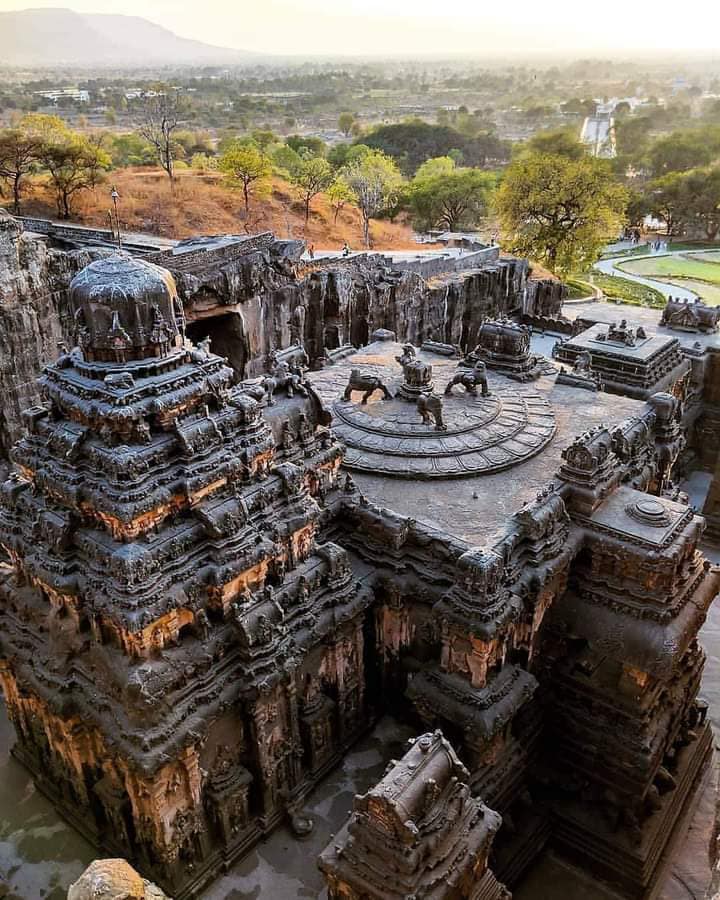Snippets of Information
Temples in Maharashtra
* 5 Jul 2023
The Shri Ambabai/Mahalakshmi Temple of Kolhapur in Maharashtra, India,
is one of the three and half Shakti Peethas listed in various puranas of
Hinduism. According to these writings, a Shakti Peetha is a place
associated with Shakti, the goddess of power. The Kolhapur Shakti Peetha
is of special religious significance being one of the six places where
it is believed that one can either obtain salvation from desires or have
them fulfilled.
Source: mahalaxmikolhapur.com
* 20 Aug 2022

Harishchandragad
is an ancient hill fort in the Ahmednagar district situated in the
Malshej Ghat, an altitude of 4,670 ft. with its origin in the 6th
century during the rule of the Kalchuri dynasty.
Harishchandreshwar temple about 16 m high from its base is an
ancient monolithic temple built in the Hemadpanti style of architecture
(style incorporating black
stone and lime without using any mortar using the technique of mortise
and tenon joint).
There are entrances from all four sides. On the main entrance there are
sculptures of faces considered the guards of the temple.
On the
left side of the entrance is a Devanagiri inscription, which is about
saint Changdev. The great sage Changdev stayed at the fort
spending his time in deep
meditation in the temple and also wrote the famous manuscript
'Tatvasaar' in the 14th century. The fort was in the control of the
Mughals in the 16th century before the mighty Marathas captured it in
the 18th century.
Around this temple there are a few caves & ancient water tanks. The
river Mangal Ganga is said to originate from one of these tanks.
A short distance away, another temple called Kashitirtha is located.
In the Nageshwar temple near Khireshwar is a 1.5 m long sculpture of Lord Vishnu in the sleeping posture - "Sheshshayi Vishnu".
Source: sahasa.in ; wikipedia.org
* 20 Aug 2022

There are three caves close to the Harishchandreshwar temple. The most mysterious is the Kedareshwar Cave
which is located to the right of the temple and has a 5 feet tall Shiva
Linga sitting in the middle of ice-cold water. The water is about
waist-high and the Shiva Linga is quite difficult to access owing to the
cold nature of water. There are lovely sculptures carved out in the
cave and is quite inaccessible in the monsoon because a huge stream
flows across the way. Another interesting point is that water
seeps into this temple every day through the four walls.
There is a huge rock above the Shiva Linga and four pillars around it
support the cave. Legend has it that these four pillars represent the
four Yugas of Satya, Treta, Dwapura and Kali. A pillar breaks off on its
own at the end of each Yuga! Currently only one of the pillars is
intact and the belief is that this fourth pillar will fall of at the end
of Kali yuga.
Source: Kedareshwar Cave at Harishchandragad, Ahmednagar, Maharashtra by Lakshmi Subramanian, sahasa.in
* 3 Jun 2022

Gondeshwar temple, built in the Hemadpanthi style of architechture
during the Adilshahi rule in Maharastra lies 30 km southeast of Nashik
city on the Nashik - Pune Highway.
The temple's origin dates back to 12 - 13th century during Yadava
dynasty. Some sources claim that Raj Govinda of Yadava dynasty built
this great temple.
It is a Shaiva Panchayatan, or a group of five temples within a large
enclosure. The central shrine is dedicated to Lord Shiva and the
remaining four around it are temples to Goddess Parvati, Lord Vishnu,
Lord Ganapati and Surya Bhagwan. The structure constructed using the
locally available black basalt stone and lime has some exquisitely
carved structures.
Source: nashik.com
The Gondeshwar temple was constructed during the reign of the Seuna
(Yadava) dynasty, and it has been variously dated to the 11th or 12th
centuries. Sinnar was a pre-imperial dynasty stronghold, and modern
historians associate it with Seunapura, a town founded by Yadava king
Seuanchandra. According to local legend, Sinnar town was founded by the
Gavali (Yadava) chief Rav Singhuni, and the Gondeshwar Mandir was built
at a cost of 200,000 rupees by his son Rav Govinda. Another theory holds
that the temple, also known as Govindeshvara, was built by the Yadava
feudatory Govinda-raja, but no historical evidence supports this theory.
Source: viharadarshani.in
According to historical records, Sinnar also known as Sindinagar or
Seunapura was governed by Bhillama III of the Seuna or Yadavas of
Devagiri as a feudatory of the Kalyani Chalukya (also known as Western
Chalukya) king Jayasimha II. However, with time this place lost its
prominence and was re-established by a Gavli chieftain, Ravi Singuni
during the 11th century. There is a bit of confusion over who built this
temple in the 12th century as one record gives credit to Ravi Singuniís
son Rav Govinda and another to Govinda Raja.
A beautiful Kurma avatar sits in the centre of the hall facing the
sanctum sanctorum which has a towering shikara over the Shiva Linga. The
rathas in the temples are in perfect harmony with the horizontal
mouldings. There are exauisitely decorated pillars, elephant bands in
the base of the walls, highly ornamented porches, floral motifs, Brahmi,
Gaja Lakshmi, Shiva performing the Tandava, Gomukh, Makara, graceful
figures of women, apsaras, gandharvas, kinnaras and panels depicting
scenes from the Ramayana, Mahabharat and Puranas.
Source: Gondeshwar Temple, Sinnar, Nashik District, Maharashtra by Lakshmi Subramanian, sahasa.in
* 1 Feb 2022
The Kailasa Mandir in Ellora

164 feet long, 108 feet wide & 100 feet high, Entire Mandir from top to bottom was cut out from solid basalt bedrock!
The largest Monolithic Structure of the World.
Source: fb Bharatvarsa : @IndiaTales7
|